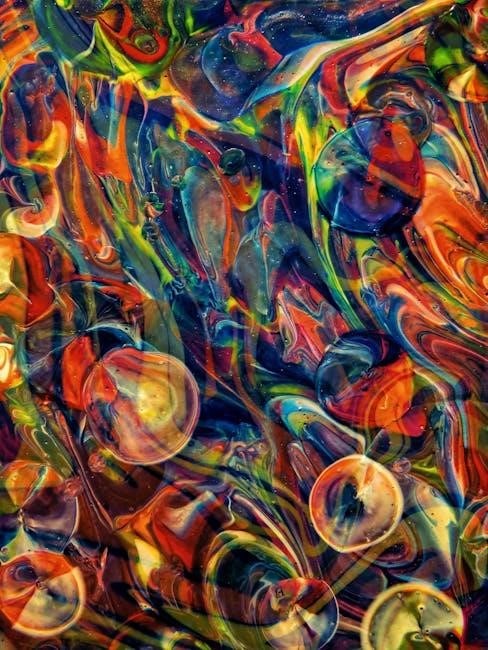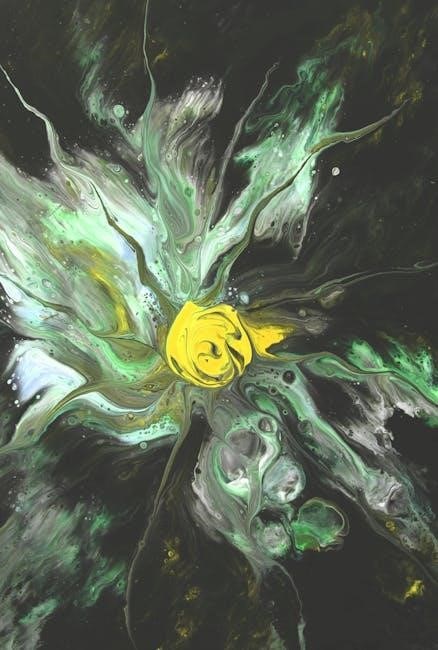Daniel E. Berlyne’s pioneering work in aesthetics and psychobiology explores how psychological processes influence aesthetic experiences. His theories emphasize collative properties, novelty, and complexity in shaping preferences, bridging art and science to understand human perception of beauty.
1.1. Definition and Scope of Aesthetics and Psychobiology
Aesthetics and psychobiology, as defined by Daniel E. Berlyne, explore the psychological and biological foundations of aesthetic experiences. This interdisciplinary field combines art, psychology, and neurobiology to study how individuals perceive and appreciate beauty. Berlyne’s work emphasizes empirical methods to understand aesthetic preferences, focusing on how novelty, complexity, and emotional responses shape artistic judgments. The scope extends to analyzing cognitive processes, sensory interactions, and the cultural context of aesthetic appreciation, providing a holistic understanding of art and beauty.
1.2. The Role of Daniel E. Berlyne in the Field
Daniel E. Berlyne was a pivotal figure in establishing aesthetics and psychobiology as a scientific discipline. His groundbreaking work introduced empirical methods to study aesthetic preferences, challenging traditional subjective approaches. Berlyne’s theories on collative properties, such as novelty and complexity, provided a framework for understanding how psychological factors influence artistic appreciation. His contributions laid the foundation for modern research in experimental aesthetics, integrating psychology, neurobiology, and art to explore human responses to beauty and creativity.

Key Concepts in Berlyne’s Theory of Aesthetics
Berlyne’s theory emphasizes collative properties, such as novelty and complexity, as central to aesthetic experiences. These elements stimulate curiosity and engagement, shaping perceptions of beauty and artistic value.
2.1. The Concept of “Collative Properties”
Berlyne introduced “collative properties” as key elements in aesthetic experiences, such as complexity, novelty, and variability. These properties arise from comparing stimuli, driving engagement and curiosity. They stimulate cognitive exploration, making artworks more intriguing and satisfying. Berlyne argued that these properties, rather than intrinsic beauty, shape aesthetic preferences, emphasizing the psychological and perceptual processes that underpin artistic appreciation and judgment.
2.2. The Role of Novelty and Complexity in Aesthetic Appreciation
Berlyne highlighted novelty and complexity as central to aesthetic appreciation. Novelty captures attention, stimulating curiosity and exploration, while complexity offers depth, preventing boredom and encouraging engagement. These elements create a balance between familiarity and surprise, enhancing aesthetic pleasure. Berlyne’s theory suggests that artworks combining these traits are more likely to evoke strong emotional and cognitive responses, making them more memorable and impactful in shaping aesthetic experiences.
2.3. The Psychological Basis of Aesthetic Preferences
Berlyne’s work emphasizes that aesthetic preferences stem from psychological processes, particularly the interaction between cognitive and emotional responses. He proposed that certain stimuli, due to their novelty or complexity, activate the brain’s reward system, creating pleasure. This theory suggests that aesthetic appreciation is not merely subjective but rooted in measurable psychological mechanisms, offering a scientific framework to understand why certain patterns, shapes, and compositions resonate with individuals universally.

Experimental Aesthetics and Its Methods
Experimental aesthetics, developed by Berlyne, focuses on studying aesthetic experiences through empirical methods. It emphasizes controlled experiments and objective measurements to understand preferences and perceptual processes scientifically.
3.1. The Development of Experimental Aesthetics as a Discipline
Experimental aesthetics emerged as a scientific approach to studying aesthetic experiences, shifting from philosophical speculation to systematic empirical study. Berlyne’s work laid the groundwork, introducing rigorous methods to analyze how psychological and sensory processes influence aesthetic preferences. This interdisciplinary field integrated psychology, art, and neuroscience, advancing understanding of human perception and appreciation of beauty through controlled experiments and objective measurements.
3.2. Berlyne’s Contributions to Experimental Aesthetics
Daniel E. Berlyne significantly advanced experimental aesthetics by introducing the concept of collative properties, such as novelty and complexity, which influence aesthetic preferences. He emphasized empirical research, shifting aesthetics from philosophical debate to scientific study through controlled experiments. His work integrated psychology and aesthetics, providing a framework to understand how cognitive and sensory processes shape artistic appreciation. Berlyne’s theories remain foundational, guiding modern studies in art, design, and behavioral sciences.
3.3. The Use of Empirical Methods in Studying Aesthetic Preferences

Berlyne’s work introduced empirical methods to study aesthetic preferences, shifting focus from theoretical debates to data-driven research. He employed experiments to measure responses to art elements like color, form, and complexity. By analyzing patterns in preference behaviors, Berlyne established a scientific basis for understanding aesthetics. His methods emphasized systematic observation and statistical analysis, enabling researchers to predict aesthetic judgments and validate theories objectively, thus advancing the field of experimental aesthetics significantly.

The Psychobiological Approach to Art Appreciation
The psychobiological approach examines how art engages the brain, emotions, and sensory systems. It explores the neural basis of aesthetic experiences, linking art appreciation to psychological and biological mechanisms.
4.1. The Neurobiological Basis of Aesthetic Experiences
The neurobiological basis of aesthetic experiences involves brain regions like the prefrontal cortex and reward system, which process pleasure, emotion, and cognitive appraisal. Neurotransmitters such as dopamine play a crucial role in mediating aesthetic pleasure. Berlyne’s theories align with these findings, as his emphasis on novelty and complexity can activate neural pathways associated with curiosity and satisfaction, highlighting the biological underpinnings of artistic appreciation.
4.2. The Role of Emotions in Aesthetic Judgments
Emotions play a central role in shaping aesthetic judgments, as they mediate the connection between sensory experiences and personal meanings. Berlyne’s theories suggest that emotional responses to art are deeply tied to psychological factors, such as novelty, complexity, and familiarity. These emotional interactions enhance aesthetic appreciation by creating a dynamic interplay between the viewer’s internal state and the external stimuli, highlighting the integral role of affect in perceptual and cognitive processes.
4.3. The Interaction Between Sensory and Cognitive Processes
The interplay between sensory and cognitive processes is crucial in aesthetic experiences, as sensory inputs trigger cognitive interpretations. Berlyne’s work highlights how sensory stimuli, such as color and form, are processed alongside cognitive functions like memory and expectation. This integration allows individuals to derive meaning and pleasure from aesthetic experiences, emphasizing the dynamic balance between perceptual and conceptual elements in shaping aesthetic judgments and preferences.

Applications of Berlyne’s Theories in Modern Contexts
Berlyne’s theories are applied in contemporary art, design, and music, enhancing creative processes through principles of novelty and complexity. His work also informs health communication strategies, leveraging aesthetic preferences to drive behavioral change and improve engagement with health materials.
5.1. Aesthetics and Psychobiology in Art and Design
Berlyne’s theories significantly influence modern art and design by emphasizing the role of collative properties, such as novelty and complexity, in creating aesthetically pleasing works. Designers leverage these principles to craft engaging visual experiences, balancing familiarity and innovation. Berlyne’s insights also guide understanding of audience preferences, enabling the creation of art that resonates emotionally and intellectually. His work bridges psychology and creativity, fostering innovative approaches in contemporary design practices.
5.2. The Relevance of Berlyne’s Work in Music and Performance
Berlyne’s theories on aesthetic appreciation extend to music and performance, where collative properties like complexity and novelty enhance emotional resonance. His work explains how musical elements such as rhythm and melody engage listeners, balancing predictability and surprise. These insights aid composers and performers in crafting impactful pieces, aligning with psychological principles to evoke deeper audience connections. Berlyne’s contributions remain vital in understanding the interplay between auditory aesthetics and human perception.
5.3. Implications for Health Communication and Behavioral Change
Berlyne’s theories on aesthetic preferences offer insights into health communication strategies. By incorporating collative properties like novelty and complexity, health messages can capture attention and engage resistant audiences. Aesthetic elements in campaigns can enhance emotional resonance, fostering motivation for behavioral change. This approach aligns with psychological principles, making health communication more effective and impactful in promoting positive behaviors and public health outcomes.

Critique and Evolution of Berlyne’s Ideas
Berlyne’s theories have faced critiques for oversimplifying aesthetic experiences. Modern psychobiology integrates neurological insights, expanding his foundational concepts. This evolution enriches understanding of art and perception.
6.1. Criticisms of Berlyne’s Theories
Berlyne’s theories have been criticized for their reductionist approach, oversimplifying aesthetic experiences. Some argue his focus on collative properties neglects cultural and contextual influences. Additionally, critics contend his emphasis on novelty and complexity may not fully capture the diversity of human aesthetic preferences. These critiques highlight the need for a more holistic understanding of aesthetics, incorporating broader psychological and sociocultural factors.
6.2. Advances in Psychobiology and Their Impact on Aesthetics
Recent advances in psychobiology, particularly in neuroimaging and emotional studies, have deepened our understanding of aesthetic experiences. These methodologies reveal how cognitive and sensory processes interact, refining Berlyne’s theories. Modern research highlights the role of dopamine in pleasure and reward, linking aesthetics to neurobiological mechanisms. Such insights have broad implications for art, design, and health communication, demonstrating how psychobiology continues to enhance the study of aesthetic preferences and behaviors.
6.3. The Integration of Berlyne’s Work with Modern Psychological Theories
Berlyne’s theories have been enriched by modern psychological frameworks, particularly in cognitive science and evolutionary psychology. His emphasis on novelty and complexity aligns with research on dopamine’s role in aesthetic pleasure. Integrating his work with contemporary theories, such as emotional processing and neuroaesthetics, provides deeper insights into aesthetic judgment. This synthesis underscores the adaptability of Berlyne’s ideas, bridging historical and modern perspectives to advance interdisciplinary research in aesthetics and psychobiology.
Daniel E. Berlyne’s work laid the foundation for understanding aesthetics and psychobiology, inspiring future research in cognitive science and neuroaesthetics, ensuring his theories remain relevant and influential.
7.1. The Legacy of Berlyne’s Work in Aesthetics and Psychobiology
Daniel E. Berlyne’s work revolutionized the understanding of aesthetics and psychobiology, establishing a foundation for empirical research. His theories on collative properties, novelty, and complexity remain influential, shaping modern studies in art, music, and design. Berlyne’s integration of psychological principles into aesthetic analysis has inspired interdisciplinary approaches, ensuring his legacy endures in both theoretical and applied domains of aesthetics and psychobiology.
7.2. Emerging Trends in the Field
Emerging trends in aesthetics and psychobiology focus on neurobiological studies, integrating fMRI research to map aesthetic experiences. There is a growing emphasis on interdisciplinary approaches, blending cognitive psychology with digital media. Modern applications in health communication and behavioral science further extend Berlyne’s principles, demonstrating the enduring relevance of his work in understanding human perception and preference.
7.3. The Potential for Interdisciplinary Research
Berlyne’s theories offer a foundation for interdisciplinary research, linking aesthetics with neuroscience, computer science, and cultural studies. By integrating psychobiology with digital media, researchers can develop new tools for studying aesthetic preferences. Collaborations between psychologists, neuroscientists, and technologists could unlock innovative approaches to understanding perception and creativity, fostering breakthroughs in both theoretical and applied domains.
